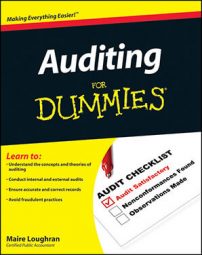Part of your job as a staff associate in an auditing firm is to document your findings in working papers (also known as workpapers) and schedules. Workpapers summarize your audit actions, such as planning the audit. Schedules show what steps you take to reach a conclusion. For example, to support your conclusion that cash is correctly stated on the balance sheet, you may prepare a schedule showing all bank reconciliations affirming that they reconcile without discrepancy to the balance sheet.
Your CPA firm specifies how you prepare all your audit documents. However, keep in mind that every workpaper stands on its own. This means that its purpose, source of information, and conclusions must be clearly evident.
To prepare workpapers, you want to use the following elements:
A descriptive heading: It should include the client’s name, the workpaper’s purpose, and the date under examination.
Indexing: Like a book, every workpaper has a unique page number showing its place in the audit file.
Cross-referencing: To improve your efficiency, you want to cross-reference your workpaper to related and supporting workpapers. Doing so eliminates the duplication of work. For example, if you file the client’s bank reconciliations in Section A and you refer to them in Section F, you don’t need to make copies of the bank reconciliations to place in Section F. Your cross-reference could be “See bank reconciliations in Section A.”
Tick marks: For the sake of brevity, you use tick marks as abbreviations for standard auditing tasks. For example, V means that the item you’re reviewing vouched (it reconciled without discrepancy) to the source document. Another common tick mark is F, which stands for foot and which means that you confirmed the arithmetic calculations on the workpaper or schedule.
The source of the information: Be sure to include what documents you examined or who you interviewed to gain evidence about the auditing matter at hand.
A conclusion: Write a summary of the results of your analysis and your opinion of the validity of the client assertion.
It may seem obvious, but it’s worth stating: All your documentation should be complete and accurate. Be concise, but make sure an uneducated user of the workpaper can follow your calculations and understand how you reached your conclusion. Neatness is also very important.

